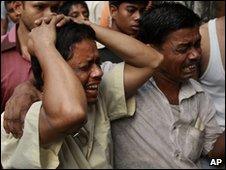Dhaka: City of construction death traps
- Published

It is the second disaster to hit poorly-built homes in a week
It is impossible to imagine how terrifying it must have been for the dozens of people caught in the fire which killed at least 116 people in the old part of the capital Dhaka.
It hit them like a bomb blast, without warning, at the time in the evening when the city's residents like to begin dinner.
It started on Thursday night when an electricity transformer exploded.
The fire soon spread to a storeroom containing chemicals and gas canisters.
Cheap accommodation
Within minutes, flames of up to 76m (250ft) shot into the air.

Crowded streets made it difficult for the emergency services
They jumped across a narrow lane and spread from building to building in a packed neighbourhood of old Dhaka, the over-congested, historic centre of the Bangladeshi capital.
The worst hit building was a badly constructed, five-storey, brick block of cheap accommodation cells.
As the fire spread from room to room, people will have found out to their horror that the windows were covered by metal grills and there was no fire-escape.
The only way out was by the front door and a leap through the flames and the smoke.
On the roof, a wedding party was in full swing. By chance, the bride survived, as she was having her make-up and hair done in a beauty salon at the time.
Neighbours helped drag people out, and then carried them to hospital.
Charred wreckage
It took the fire brigade more than one hour to reach the inferno, even though their headquarters are less than 1km away.

Metal grills prevented many from escaping
Their progress along the narrow lanes of the old city was slowed by the people, cars and rickshaws in their way.
Almost 24 hours later, the rescue services are still there, searching through the charred wreckage of homes, shops and warehouses for bodies.
One burnt corpse was found half buried in a sewer, next to the remains of a grocery shop - its torso covered by piles of burnt chillies and other spices.
In the mosque around the corner, a huge crowd of mourners gathered to hear special prayers.
The relatives of those who died then carried coffins high above everyone's heads and on to waiting trucks.
It is the worst fire that anyone can remember, but it is not an isolated incident.
This is the second disaster to strike a poorly built accommodation block in Dhaka this week.
On Tuesday night, in another part of town, a building suddenly collapsed when the ground beneath it subsided, killing 25 people.
It had been built illegally on what used to be a canal, before a developer had filled it in with sand.
In both cases it seems pretty clear that builders and landlords had ignored Bangladesh's planning and safety regulations.
But that is the norm for Dhaka, a city of 15 million, and one of the world's fastest growing.
Because it is surrounded by flood plains, there is nowhere else for it expand, except into the sky.
Even tin shanties now often have many storeys.
Instead of constructing proper foundations, or installing a fire-escape, for example, the developers pay bribes to officials and politicians.
As a result there are thousands of these death traps across the city.
Indeed there is a danger that they will all fall down if a powerful earthquake strikes, which the government has warned could happen at any time.
- Published4 June 2010